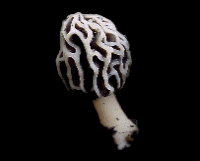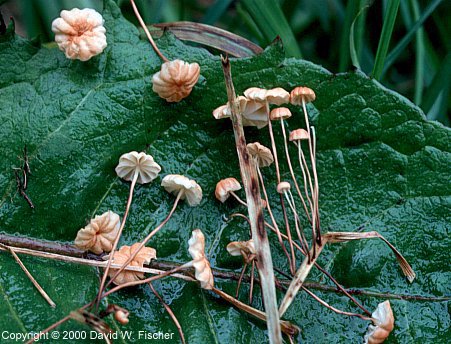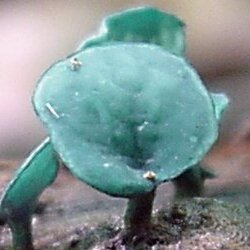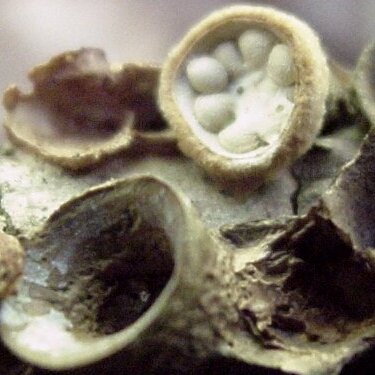








America's TINIEST Mushrooms
IMPORTANT NOTE
This resource is posted without warranty as to absolute taxonomic determination. In other words, it is possible that I have mislabelled a mushroom here! I am always grateful for corrections (contact me at mycology@aol.com).
DO NOT use these photos as a tool for safe identification of edible wild mushrooms—use resources that are designed for that purpose:
Edible Wild Mushrooms of North America
America's Best, Safest Edible Wild Mushrooms
I get a special excitement from seeking, finding, and photographing the tiniest mushrooms. Some of them are very common, yet are nearly never noticed—simply because they're so tiny that you have to actively look for them in order to find them. Here are some examples…

The Bark Mycena (Mycena corticola) really is tiny—its cap is usually less than one-quarter inch wide—and a typical specimen has only about a dozen gills! To find it, you'll need a big tree to inspect, as the Bark Mycena grows on the dead outer bark layer on big trees (especially maples and oaks). It often grows alongside mosses and lichens which are essentially doing the same thing on that bark—eking out a living in a harsh, barren environment.
This miniscule mushroom has a special adaptation for living where it can easily go from wet to dry in a very short time. It will grow, mature, and begin producing spores under moist conditions; if the weather dries it out, it will shrivel to a withered remnant of its former self, but when rain or other moisture permits, it will "revive" itself with water and begin producing spores all over again.
That outer layer of dead bark provides the tree with a very important extra layer of protection against insects, parasitic fungi, and harsh weather. The relationship between the tree and the tiny mushroom—and between the tree and the lichen, and between the tree and the moss—requires the supported organisms to be very gentle to the host trees. If they "ate" too much bark from too many trees, they could exterminate their own hosts, causing their own extinction!
I think there's a lesson in that.

In the Northeast, around late August or so into September, if you get up quite early, while the dew is still wet on the ground, head for the lawn, and crawl around on your hands and your knees very carefully looking, there's a pretty good chance you could find the Grassblade Marasmius (Marasmius graminum), a common lawn species whose simple purpose in life is to digest dead grass blades and then to reproduce. Like most species of Marasmius—and of course the Bark Mycena—it can dry out and shrivel, then revive with rain or dew and start producing spores again.
Locating this tiny mushroom on a lawn that's still moist from rain or dew is enough of a challenge; locating it on a dry lawn is nearly impossible. If you want to find it, get out on your lawn on your hands and knees at first light and accept that you will get soaked seeking it!
But make sure your neighbors don't see you, or they might think that you lost…
…something…

In addition to several common tiny species which are generally fairly easy to identify—in part because of their minute proportions—every now and then I come across a mini-mushroom I can't put a name on. I've shown the photograph on the right to plenty of mycologists, and none has a strong opinion about even what genus this very delicate and very small white gilled mushroom might belong to.
The only way to begin to identify something like this is to look at the spores and other parts of the mushroom under the microscope. The problem in the case of a specimen this tiny and this delicate is that once you slice off a tiny sample to mount on a glass slide, there's not much left of the specimen… and that's especially problematic when only one specimen can be found!
I spent an hour combing the ground looking for more of these, without success. The only reason I found this one in the first place is because I was on my belly photographing another, considerably larger, mushroom that was growing just inches away.

This is one of numerous mushrooms that grow exclusively on other mushrooms. Like most of these so-called "hyperparasites," this one (Phaeocalicium polyporaeum) is peculiar to a specific host: in this case, it's a leathery species of "bracket fungus" named the Violet Toothed Polypore. A closer relative of cup mushrooms and morels than to any polypores, this is probably the smallest fungal sexual reproductive structure that I'm willing to call a "mushroom"—it's really tiny… and at under one sixteenth of an inch in height, it's very easily missed!

The tiny Green-stain Cup Mushroom (Chlorociboria aeruginascens) is always a delight to find, and it gives its location away to the careful observer by turning large sections of the dead wood it grows on bluish green! They're not easy to find: They're little more than half an inch tall or wide at most, and they don't last very long before they shrivel and disintegrate.

Bird's Nest mushrooms are nifty! The several common North American species, including the White-egg Bird's Nest mushroom (Crucibulum laeve) are no more than a quarter inch wide. The "eggs" (technically called peridioles) are puffball-like packets of spores; they're dislodged by raindrops and use tiny coiled cords to hitch a ride on a passing animal… so this spore does, in a literal sense, "fall" far from the "tree." Bird's Nest mushrooms are very common in beds of old woodchip mulch; last year's empty nests are very persistent and can still be found after a long cold winter.

Within a few groups of mushrooms, one or two species stand out from the rest by virtue of their diminutive size. None is a finer example of this phenomenon than this miniscule earthstar mushroom, which has the appropriate name of Geastrum minimum.
Earthstar mushrooms are common on the forest floor, where they decay dead wood for a living. An Earthstar mushroom is a sort of puffball, but the spore case has an extra layer that splits open at maturity, forming starlike rays around the spore case.
The tiny Geastrum minimum is readily distinguished from the others by its minimal size—typically well under 1/2" wide! (Yes, that is the white head of a paper match in the photo.) Unlike most earthstar mushrooms, G. minimum is not found on the rich humus of the forest floor, but on relatively barren sand dunes: Amateur mycologist Paula DeSanto finds this mushroom to be a common member of the dunes mycoflora along the southeastern shore of Lake Ontario in late fall.
We have considered a handful—a very small handful, at that!—of fascinating fungi of truly Lilliputian proportions. Certainly there are others that deserve attention on this page… so nominate another tiny mushroom for recognition by sending me an E-mail!
Sorry, myxomycetologists, but slime molds aren't eligible!
AMERICANMUSHROOMS.COM SITE INDEX
about • mushroom basics • coolest mushrooms • edible mushrooms •
1,046 mushroom photos! • HOME • lawn & garden mushrooms • mushroom links • medicinal mushrooms
morel mushrooms • mushroom I.D. • mushroom photography • mushroom show • music • mushroom odors • psilocybin mushrooms • schedule • store • tiniest mushrooms • toxic mushrooms
To contact David Fischer, send an e-mail to…

All content at americanmushrooms.com is Copyright © 2006, 2007 by David W. Fischer. All rights reserved.





